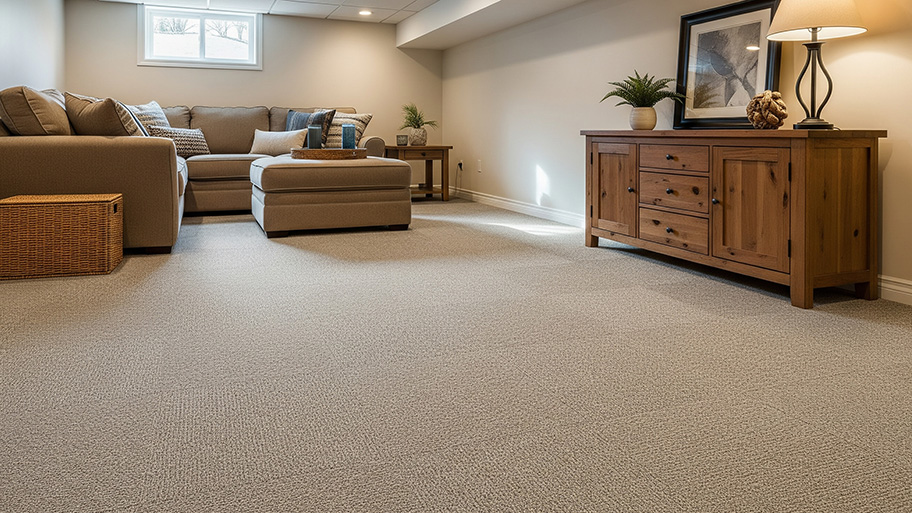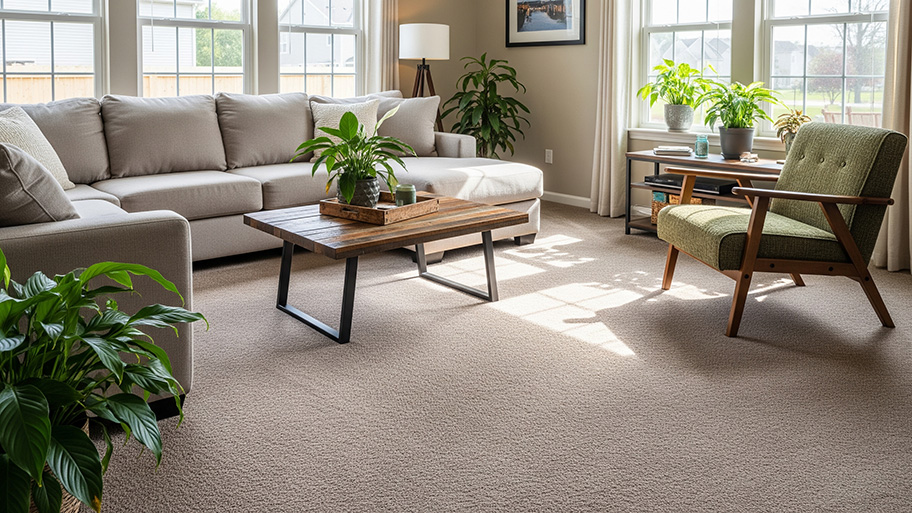
Carpet padding makes your carpet feel extra comfortable and protects your floors from damage, but how much does carpet padding cost? Let’s look at the numbers.
Act quickly to preserve your carpet and avoid mold growth


A burst pipe, a backed-up drain, an internal sprinkler system, or a leaky appliance—there are many potential sources of water damage throughout your home. Regardless of what caused the flooding, it’s important to take action quickly to prevent further damage and mold growth. But what do you do specifically if your carpet gets soaked? Let’s discuss how to get water out of your carpet to get your living space back to normal as quickly as possible.
Before you begin trying to soak up the water and dry out the carpet, you need to figure out why the carpet is drenched in the first place and take care of the issue. Otherwise, you’ll just continue to see the same problem again and again.
It could be a broken appliance, flooding from a storm, a burst or leaky pipe, or something else entirely. But you’ll want to call a local water damage restoration specialist, an emergency plumber, or a leak detection specialist to find and fix the issue as soon as possible. Until it’s fixed, you risk more water seeping into your carpet, and all of your drying efforts will be undone.
You should understand the categories of water damage that can affect your home, too. For clean water from water supply lines, rain, flooding, or snow, plumbers, water damage restoration specialists, and even general contractors will be able to tackle the work. For grey water, stick with specialists or plumbers, and for black water, always call a water damage specialist.
The next thing you’ll want to do is remove all your belongings from the room, including furniture. At this time, you can inspect your furniture to see if it’s been water-damaged. If it has, you’ll also need to make a plan to dry out and sanitize your furniture before mold begins to grow.
We recommend wearing protective gloves while dealing with water damage. It’s a good idea to wear a face mask as well, especially if you have respiratory issues.
Use a wet/dry shop vacuum to suck up as much of the water from the carpet as possible. Always remember to remove the collection bag and dry filter and install the wet filter, if applicable.
Don’t rush this step. It’s important to suck up as much water as possible, going over the same area repeatedly. The more water you pull out with your vacuum, the more effective the following steps will be.
After you’ve thoroughly vacuumed up the water, use old towels to soak up any remaining moisture in the carpet. Apply as much pressure as possible to every inch of the towels to ensure they’re thoroughly sopping up the water.
Next, sprinkle a liberal amount of baking soda all over the affected area of the carpet. Baking soda is great at soaking up water deep within your carpet and also doubles as a deodorizer for any resulting mildew smells.
Leave the baking soda on the carpet for at least an hour before vacuuming it up. Repeat this multiple times, as needed.
To dry out the water-damaged carpet further, you’ll need to create airflow in the room. Turn on any ceiling fans, open all the windows, and use box fans and pedestal fans to create airflow over the affected area. The best course of action here would be to rent and set up blower fans and dehumidifiers and run them for 24 to 72 hours. These will dry out your carpet and the padding underneath to prevent mold growth after the water damage.
If you have a steam cleaner (or are willing to rent one), steam cleaning the carpet is a good idea to sanitize it and remove odors. You can also hire a local carpet steam cleaner to handle the job for you.
Alternatively, you can purchase an antibacterial carpet sanitizer to run through your carpet cleaner to prevent the growth of mold and mildew. In addition to the carpet, you should thoroughly sanitize any other surfaces that suffer from water damage.
If the water damage was extensive enough, it could have damaged the carpet padding or subfloor. You can use a carpet moisture reader (available at a hardware store) to detect the moisture level beneath your carpet or simply pull up a corner of the carpet to inspect what’s going on underneath.
If you’re not comfortable with the steps above—or if you determine that your carpet padding and/or subfloor were damaged during the previous step—it’s time to stow away the wet vac and towels and call a professional water damage restoration company near you.
These companies can do more extensive remediation to your flooring, furniture, and any other parts of your home affected by the water damage. Teams can tackle both water damage and mold in their remediation, and they can repair subfloor and floor joist damage that could result in structural issues if unaddressed.
Removing water from a carpet isn’t terribly complicated, but there are some mistakes that are easy to make that can lead to additional property damage. Here are some things to avoid while you’re getting water out of your carpet.
Failing to fix the source of the leak: It’s easy to address the symptom of the water damage and forget about the source, but that’s a big mistake. Make sure you determine why you experienced water damage and hire a water damage restoration professional to address the problem. Otherwise, you’ll continue to see water damage in the future.
Not running fans for long enough: Don’t stop running your blower fans and dehumidifiers once the carpet feels dry because the padding below could also be wet. Make sure you run fans continuously for 24 to 72 hours, depending on the severity of the leak.
Not being proactive about mold growth: Mold growth can begin just 12 to 24 hours after water damage, and it’s more likely to be an issue with absorbent materials like carpet. Start drying your carpets immediately, and don’t skip the steam cleaning and sanitizing. These will both help prevent mold from growing and returning in the future.
Failing to check the subfloor for damage: Another big mistake is ignoring that your subfloor could be damaged. At the very least, you should pull up a corner of the carpet to assess the subfloor. If you find damage or mold, call a professional for help.
Minor spills and leaks that get your carpet wet are usually easy enough to tackle on your own. Spend the day using a wet vac, towels, baking soda, and blower fans to sop up the water and dry out the carpet, and don’t forget to sanitize. In most cases, this will suffice.
But if there’s more extensive flooding, such that the carpet is heavily drenched or the carpet padding and subfloor are at risk of damage, it’s best to call a pro to tackle the issue. This is important both to prevent the spread of mold and to ensure the structural integrity of your floor.
On average, water damage restoration costs between $1,350 and $6,300, but depending on your policy, your homeowners insurance may cover some or all of the cost.
Very easy to work with. The installers were very efficient.
The provider arrived at the designated time and went right to work. He was very thorough and left our carpets smelling and looking clean. He did a great job on a staircase that we have trouble keeping clean. I would call them again in the future.
Incredibly impressed with the job that was done. We had very old and stained carpet and I had low expectations on how well they could get it cleaned up based on the poor job a previous carpet cleaner had done. Many pet stains and traffic area issues but Elite was able to get them all cleaned...
With the help of a contractor, I did a full basement finish, and Dawn Marie and the team at Simply Floors made the flooring portion of my project easy and high quality. Dawn Marie was my primary contact throughout the 3+ months that I was in and out of the store. She was patient, informative,...
Fantastic, professional, great family business. Did a lovely job with my carpets, and communicated thoughtfully during the process.
My carpets were very soiled. They got out all the dirt.
Found Kathy on the list along with 3 others, placed calls and she was the first I spoke with. I explained what I needed to have done, what the size of rooms were, carpet type, etc. She explained the process, time frame and cost. Enjoyed speaking with her and waited to receive paperwork...
From average costs to expert advice, get all the answers you need to get your job done.

Carpet padding makes your carpet feel extra comfortable and protects your floors from damage, but how much does carpet padding cost? Let’s look at the numbers.

The cost to carpet stairs depends on the number of stairs, material choice, and staircase type. Read on to calculate your project expenses

Not only are carpet tiles easier to install than carpet, but they’re often more affordable. So, how much does carpet tile installation cost? Let’s take a look.

If your carpet has seen better days, it might be time to give it some TLC. These questions to ask your carpet installer will help you prepare for the project.

While challenging, you can learn how to carpet stairs properly. Use these 12 steps to carpet your stairs using either the waterfall or the upholstered method.

Keeping your carpet looking new and clean means taking the time to revive carpet pile, which is a combination of the type, length, and thickness of its fibers.